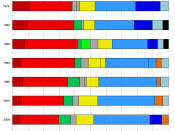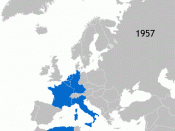Introduction -The Treaties of the EU
In February 1992 the signing of the Treaty of the European Union (TEU) concluded the Maastricht IGC. Undoubtedly the popular profile of the Community was raised more by the Maastricht debate than by any other development in the Community's history. Apart from the detailed commitment to full economic and monetary Union, the most obvious feature of the TEU was the institutional change it brought by establishing a three-pillar structure. The TEU, absorbed the pre-existing European Community, which remained primarily economic in structure into the constitution of the European Union. The first pillar in this innovative structure is the Community dimension, which relates to the three communities. The two other pillars, which Craig and De Burca refer to as the two intergovernmental pillars, are Common Foreign and Security Pillar and Cooperation on Justice and home affairs.�
The Maastricht TEU introduced a number of changes in the voting system in the Council of Ministers.
It increased the number of articles subject to qualified majority voting. It also introduced a new voting procedure, referred to as the co-decision procedure. The cooperation procedure introduced by the SEA was preserved. However the co-decision procedure was intended to strike an even more balance of power between the institutions and, in particular, gave the EP the power ultimately to reject legislation. Through the co decision procedure thus decision-making power is shared more equally between the parliament and the Council. The procedure here is basically that a conciliation committee made up of equal numbers of members of parliament and of the Council, with the Commission present seek a compromise on a text that the council and parliament can both subsequently endorse. If there is no agreement parliament can reject the proposal outright.
The Three Pillars
The first pillar is made up...



Kind of confused here...
Lots of acronyms at the beginning - like SEA, IGC, EP, CFSP - that had no definitions. I had to google them to find out what was being discussed.
Also, the first paragraph has a lot of references mentioned, no citations associated with them. Found references but couldn't find a citation anywhere on the posted doc.
The intro paragraph really didn't provide what the paper was going to specifically talk about and even started describing pillars which I had to google to figure out what was being said.
I think (my own opinion) that the first sentence should be explained. Googled it and found it at www.historiasiglo20.org/europe/maastricht.htm.
S orry, but I was thoroughly confused with what this paper was trying to achieve. Maybe it's just me and this is way over my head but I thought it sounded like it came straight out of a law book or The Economist or Wall Street Journal. It didn't sound like a (Bach) student's own thoughts, at all but a string of citations (uncited, of course).
2 out of 2 people found this comment useful.